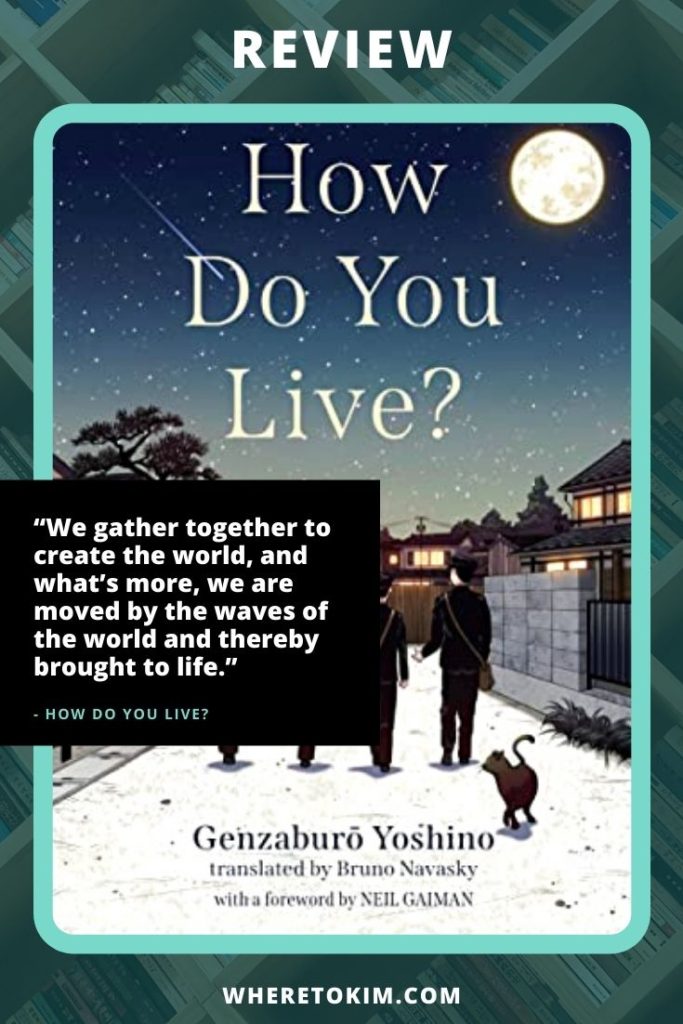How Do you Live? by Genzaburō Yoshino challenges you to answer this question from both the rooftop and the street, the middle of the city and the ocean.
Location: Tokyo in the year 1937, Japan
How Do You Live? synopsis
Anime master Hayao Miyazaki’s favorite childhood book, in English for the first time.
First published in 1937, Genzaburō Yoshino’s How Do You Live? has long been acknowledged in Japan as a crossover classic for young readers. Academy Award–winning animator Hayao Miyazaki (Spirited Away, My Neighbor Totoro, Howl’s Moving Castle) has called it his favorite childhood book and announced plans to emerge from retirement to make it the basis of a final film.
How Do You Live? is narrated in two voices. The first belongs to Copper, fifteen, who after the death of his father must confront inevitable and enormous change, including his own betrayal of his best friend. In between episodes of Copper’s emerging story, his uncle writes to him in a journal, sharing knowledge and offering advice on life’s big questions as Copper begins to encounter them. Over the course of the story, Copper, like his namesake Copernicus, looks to the stars, and uses his discoveries about the heavens, earth, and human nature to answer the question of how he will live.
This first-ever English-language translation of a Japanese classic about finding one’s place in a world both infinitely large and unimaginably small is perfect for readers of philosophical fiction like The Alchemist and The Little Prince, as well as Miyazaki fans eager to understand one of his most important influences.
Book review
“When we look back on our actions […] I’m afraid there’s nothing quite so painful as thinking, What have I done?”
Ask yourself what it is that a certain great person or hero has achieved with their vitality. Even though they, like all of us, are nothing more than drops of water in human existence.
Ride the wave
From the relatively distant perspective of 1930s Japan, Copper and his uncle become your guides in science, ethics and thinking. Standing on a rooftop, they compare the view from the roof to a view from the street, and cars to rhinoceros beetles and the city to the ocean: it’s all just a matter of perspective. Like everything else in life.
Genzaburō Yoshino effectively sets the scene and mood with beautiful and detailed descriptions in the early chapters. Copper constantly changes perspective in his observations of the world around him, making you turn the situation over in your mind as well. The book is very quotable and many pages present something to think about in an attempt to help you answer the question that is also the name of the book.
The translation reads smoothly (kudos to the translator). I hope the same is true of the Japanese original, as Japanese children are the target audience of the original version, which strives to teach them life lessons, science and history. The book also touches on topics such as what it means to be rich and bullying at school in a 1937 setting.
Model citizen
Copper is on his way to learning to stand up for what is right with the goal of becoming a first-rate student and a man of great virtue. The “how” is something he must figure out for himself, according to his uncle who gives him advice in his notebook. The uncle says that there are things that no one can teach you, because you have to experience them. However, you can start by building on real feelings from a situation where your heart was really moved. You don’t have to be flawless as long as you are your own man and follow your own definition of great (or Napoleon’s, of course).
Like the self-development books that are so popular these days, this book also teaches you some essential things about life, such as how to take responsibility for your actions and accept your mistakes. My main takeaway is as follows: your good intentions mean nothing if you miss the opportunity to act. It’s nothing I haven’t heard before, but it’s a good reminder. One that was written down 85 years ago. If you read this book in the spirit of its time, and interpret the teachings accordingly, How do you Live? is an interesting book to read.
Interested?
Get your copy of How Do You Live? from Amazon.
Book details
Title: How Do You Live?
Author: Genzaburō Yoshino
Translator (from Japanese): Bruno Navasky
Language: English
Publisher: Algonquin Young Readers
Pages: 288
ISBN (13): 9781616209773
Publication date: 26 October 2021
About the author and translator
Genzaburō Yoshino (1899-1981) was a writer, editor and journalist. In 1935, the writer Yamamoto appointed him editor-in-chief of the 16-book series: A Library for Young Japanese Nationals. How Do You Live? is the final book in this series, bringing in themes of Marxism, antimilitarism and Buddhism.
Bruno Navasky is a teacher and writer, whose work as a translator and editor includes Festival in My Heart: Poems by Japanese Children and Poem in Your Pocket for Young Poets. He was the founding editor of American Poet, the journal of The Academy of American Poets, where he now serves on the board of directors. He lives and works in New York City.







